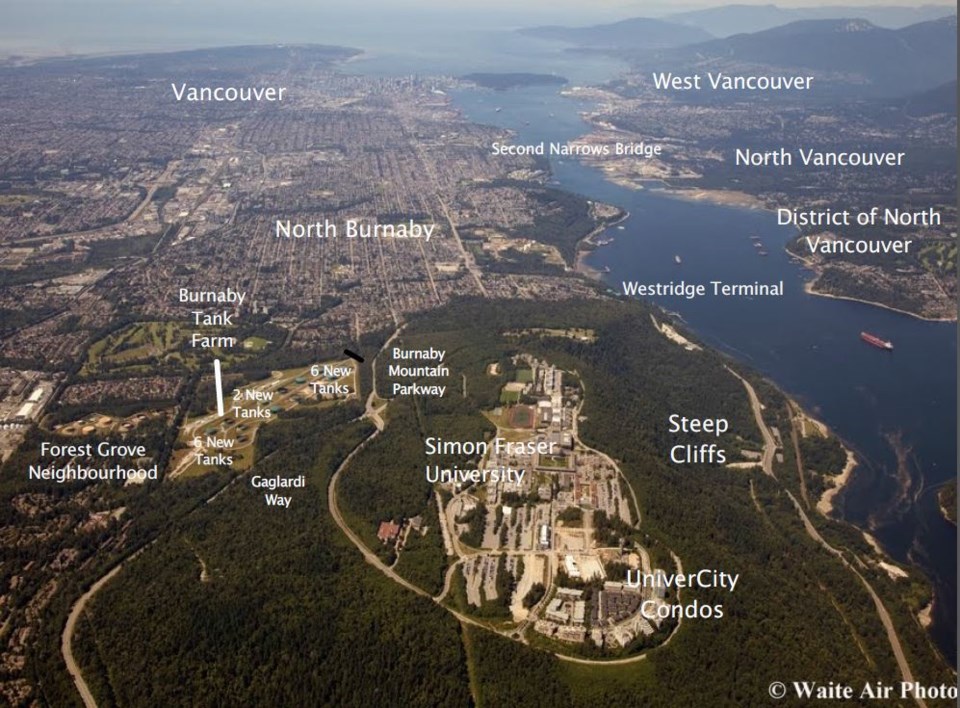Simon Fraser University’s new chief safety officer is bracing for the Kinder Morgan pipeline expansion and trying to figure out how to keep 20,000 people safe in the event of a major fire at the nearby tank farm.
“I’m proceeding on the assumption that the project will be approved, and the reason for that is I want to have our plans and resources in place, tested and validated before the expansion begins or is in place,” said Mark LaLonde, chief safety officer for SFU. “I don’t want to wait until they put a shovel in the ground. It’s going to take time to develop a robust and appropriate emergency plan.”
Last year, the Burnaby Fire Department released a report, outlining a number of worst-case scenarios for the tank farm, including earthquakes, flammable crude leaks, poisonous gases, fires burning for days and exploding tanks that spray hot crude, igniting other nearby tanks. The biggest concern was a wildfire spreading on the mountain, close to homes and SFU. The Burnaby Mountain campus poses particular challenges, as the only two roads down the mountain intersect close to the tank farm. When the NOW first reported on this issue in spring of 2015, then chief safety office Terry Waterhouse said there was no plan except to “shelter in place.”
LaLonde said he has been on the job for three months, and the Kinder Morgan file has been a top priority.
“We currently have no mass evacuation plan for a major disaster like that,” LaLonde said. “But when the tank farm was built 50 years ago, no one thought of this.
“If it’s a large event, we’re probably going to have to shelter in place, so where do we put people? What HVAC systems can we turn on quickly to stop the fumes from coming inside?” LaLonde said.
The weather on Burnaby Mountain could be a major factor in how a disaster would unfold, he explained. For example, on a clear, calm day, toxins from the smoke plumes could go straight up into the air, but rain could cause settling on the mountain.
“We need to take all these things into our plans. This is not an easy process, it’s not a simple process and not inexpensive,” LaLonde said.
“We’d love Kinder Morgan to pay for it,” he added. “We’re always fighting for more funds, and emergency planning is always one of those challenges.”
The federal government’s final decision on the pipeline is due Dec. 19.
LaLonde said he needs 12 months to come up with a plan. If Kinder Morgan gets the final approval, construction is scheduled to start in September 2017.
Kristin Linklater, executive director of SFU’s communications and marketing department, emailed a statement to the NOW on the matter.
“The health and safety of the SFU community - people who live, work and go to school on Burnaby Mountain - is our highest priority,” the statement reads. “Studies we have commissioned in the past raise serious concerns about the risks of this proposed project to the health and safety of the SFU community. We played an active role as an intervenor on this issue, and the (National Energy Board) has listened to the concerns we raised. The NEB echoed many of the university’s concerns around emergency consultation and planning as well as gaps related to the proposed tank farm expansion’s risk assessment. SFU will continue to work with Kinder Morgan, local emergency services and other stakeholders to identify how the NEB decision will impact our campus so we can ensure the continued safety of our campus community. We will continue to advocate our remaining concerns to the federal government and Kinder Morgan.”



